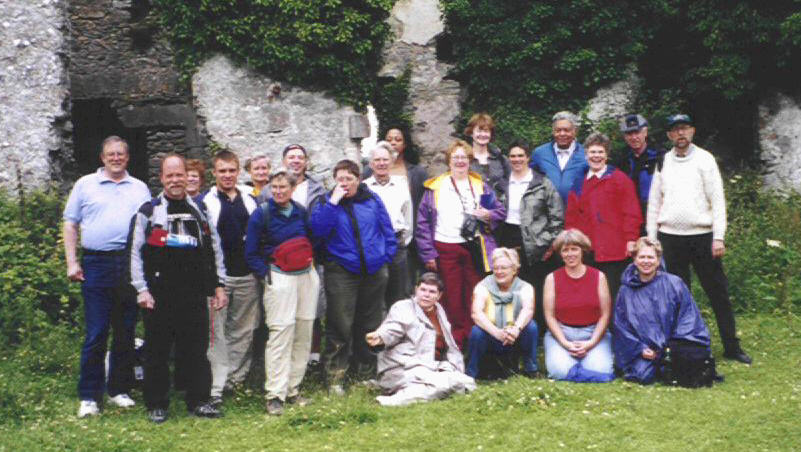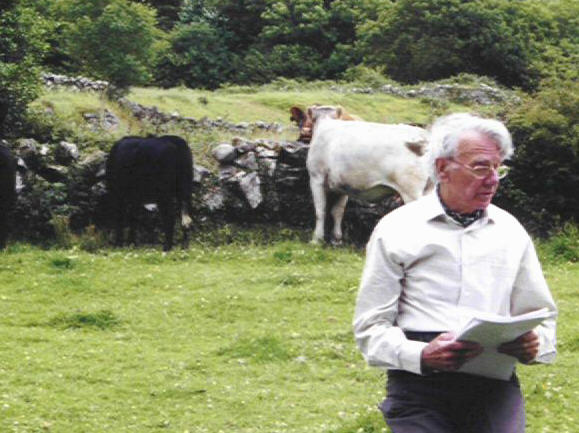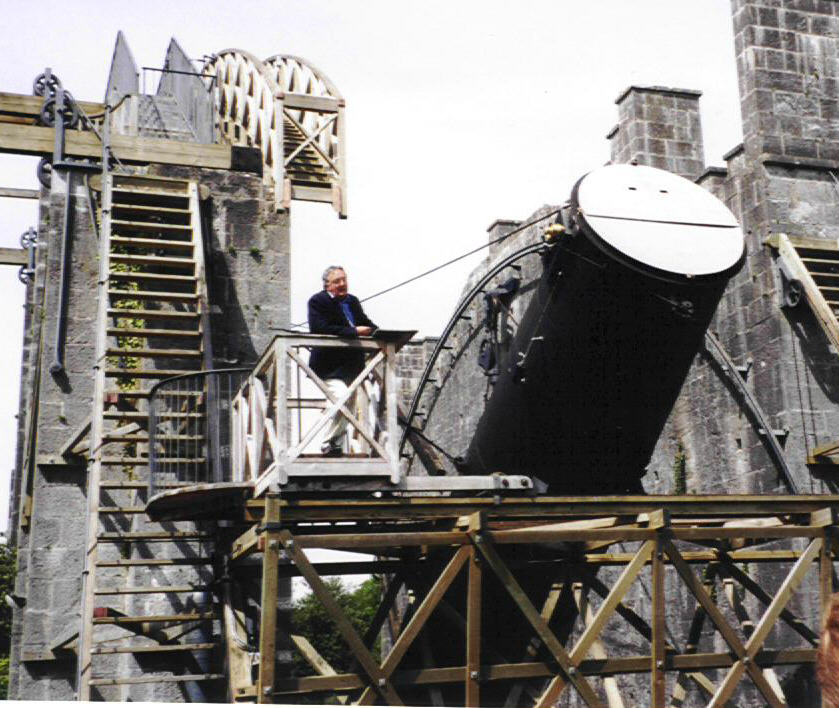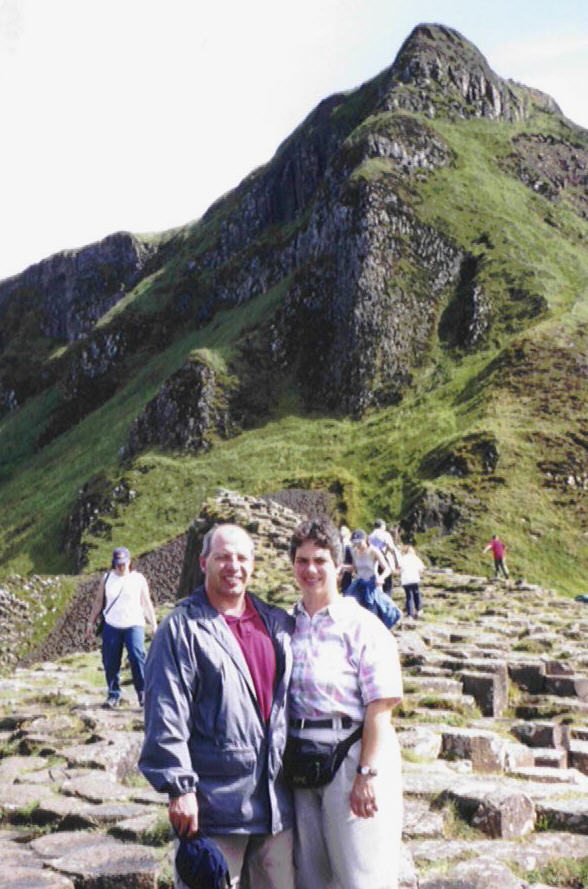
Educators in Quest of Irelandís Contributions to Science
By Sean OíConnor
A group of science teachers from the United States toured Ireland between June 20th and July 4th. This group was part of Science History Tours, a non- profit organization led by Yvonne Twomey and Lee Marek. These two are an excellent team. While the travel savvy Yvonne was the obvious leader of the tour, Lee, a renowned chemistry teacher, kept the group on task and provided entertaining commentary throughout the trip.

The Science History Tours group at Blake Castle in Menlough.
Although the trip was mainly marketed to chemistry teachers there were activities of interest to all science teachers and history buffs alike. The tour centered on intellectually stimulating lectures by several guest speakers. The topics of these lectures ranged from education to seaweed.
The Chemicals from Seaweed lecture given by Dr. Peter Childs at the University of Limerick was of particular interest. The lecture described the progression of the processing of seaweed in Ireland and how important it was to the economy of coastal Irish communities. Dr. Childs used samples of contemporary art and literature to depict life in these communities and illustrate the importance of the seaweed industry.
At University College Cork, Dr. Sean Pettit gave a lecture on the history of science. His enthusiastic talk provided information on the formation of early scientific groups such as the Royal and Lunar Societies and how these early organizations developed into modern science education. Dr. Pettit is an excellent orator and used every public speaking technique (including a good dose of humor) known to man to keep his audience engaged.

Dr. Davis delivering his lecture on Kirwan.
At Blake Castle in Menlough, Dr. Bill Davis lectured (al fresco) on the life of Irish chemist Richard Kirwan. Dr. Davis endured livestock and an occasional shower while providing information on Kirwanís life and the phlogiston theory. Dr. Davis joined us again towards the end of the tour at Trinity College to give two lectures: one on inventor Richard Lovell Edgeworth and the other on chemist William James McNeven.
In addition to this excellent set of lectures, there were several museum stops. In Cork, Paddy Clark gave a presentation on the history of communication (specifically wireless telegraph and radio) and gave us a personal tour of the Radio Museum at Cork City Gaol. Mr. Clark is a collector and is responsible for arranging the exhibits in the museum. His tour included a visit to a storage area that holds a portion of his collection, including vintage pieces that will be part of future exhibits.
While in Birr, before lunching with Lord Rosse and touring the grounds of Birr Castle, Lord Rosse provided a guided tour of the Historic Science Center. The Center focuses on the scientific and technological contributions of the Parsons family. The most notable of these contributions was the construction of the Great Telescope by the Third Earl of Rosse. The Third Earl was the first person to observe and sketch the Whirlpool Nebula using this telescope. While touring the gardens (a must for biology and horticulture teachers) of the castle we were able to see a demonstration of the restored telescope in action. Lee was impressed by the engineering skills of the Third Earl who designed a series of counter-weights to raise the barrel of the telescope.

Raising the Great Telescope at Birr.
We traveled to Lisburn to visit the Lisburn Irish Linen Centre and Museum to learn how flax is processed and woven into cloth. The history of the bleaching process was of particular interest to the chemistry teachers on the tour. The process remained unchanged until the introduction of sulfuric acid and modern chemistry.
Of special interest to the physics teachers on the tour was our trip to the Maynooth College Museum. This museum was filled with religious artifacts and Nicholas Callanís equipment related to his invention of the induction coil. The construction of his equipment (which utilized miles of copper wire) was a phenomenal accomplishment considering the limited technology of the time.
The tour was more than science teachers fulfilling a need to learn. Many of the other days were spent enjoying the natural beauty, non-scientific history and friendly people of Ireland. Much of the natural beauty was viewed from the coach that transported us from place to place. By not having to pay attention to the road we were free to view the vast miles and shades of green hillside, the cloud veiled mountains, the rocky limestone of the Burren, the tidal bays and rivers and the lush forests of Ireland. The only terrain that Ireland seems to lack is an arid desert. The most impressive bit of nature the group observed was the Giantís Causeway. These naturally formed hexagonal basalt columns provide an apparent man-made cobble stone road to the ocean.

Tour members Sean and Robin OíConnor at the Giantís Causeway.
It is impossible to tour Ireland without visiting some of the many castles, cathedrals and abbeys. There were so many, each with its own unique character and role in Irelandís turbulent history that I will only list a few of the many seen on the trip. There was Lismore (the birthplace of Robert Boyle), Bunratty, Cahir, King Johnís and Dunluce castles. We saw the Cathedral of our Lady in Galway, Kylemore Abbey and St. Patrickís Rock of Cashel. Thanks to our coach driver we never missed a roadside "tower house" or high cross. His knowledge of Irelandís history and countryside proved to be invaluable.
Starting with our coach driver Patrick and continuing at every stop along our fifteen day trip, everyone we met made us feel welcome and at home in Ireland. Each person we met went out of their way to share their knowledge and make us feel comfortable in our new surroundings. As a tour member and first time visitor to Ireland, I can say that I thoroughly enjoyed my time in such a scenic place and hope to make many return trips.
|
|
|